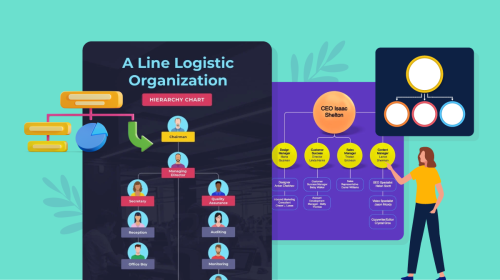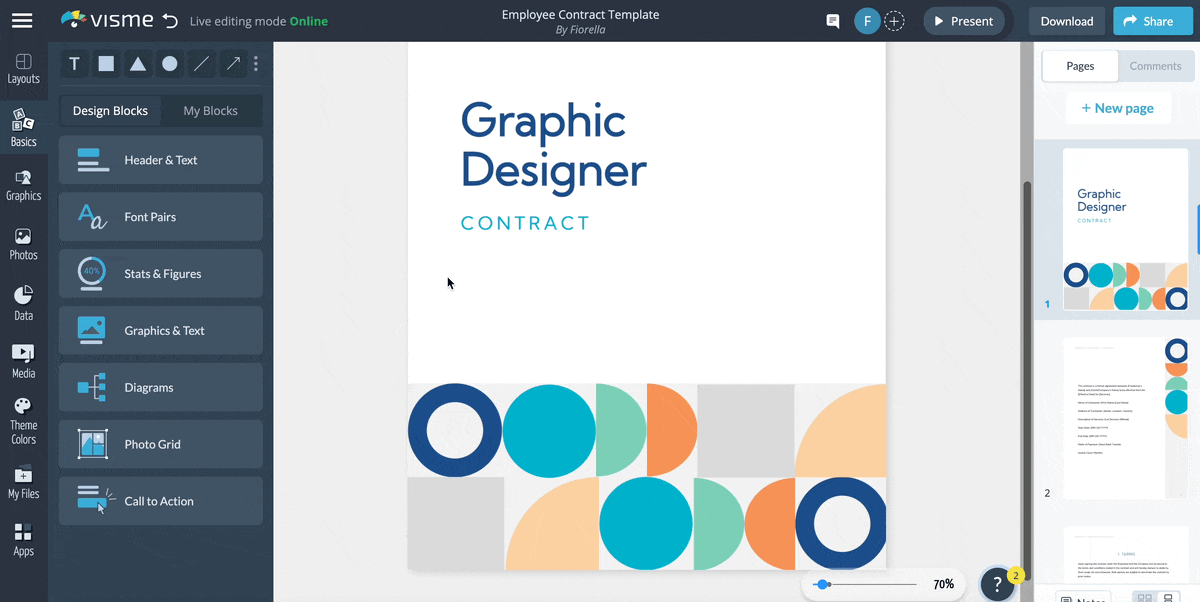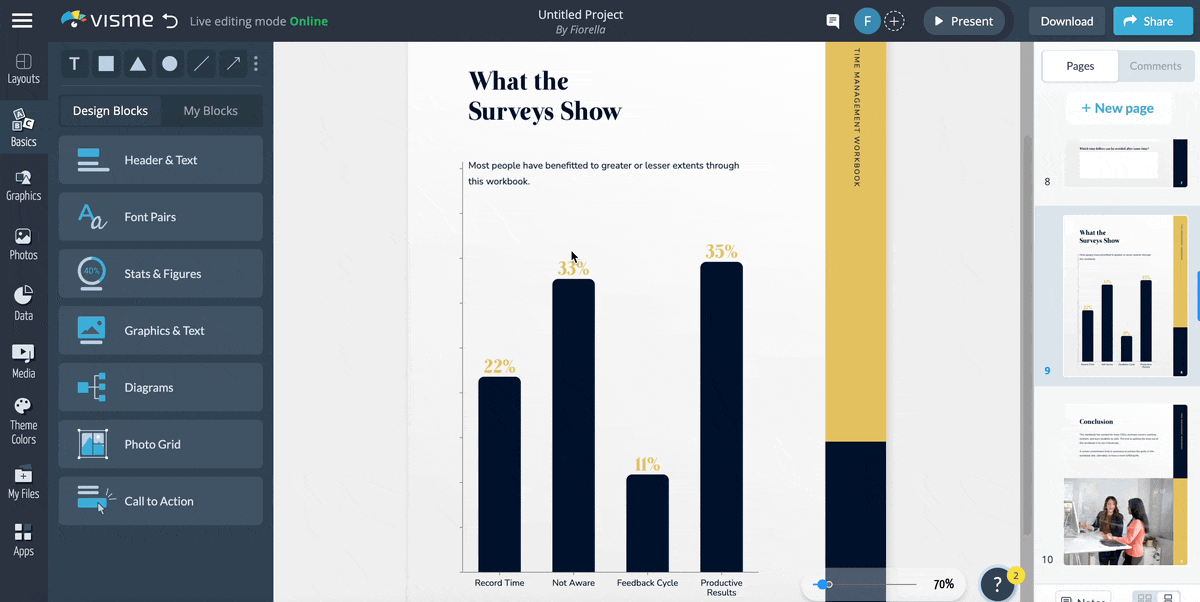
What Does Human Resources Do? Understanding Key Roles & Responsibilities


What does HR do? The answer to this question isn't exactly simple.
The role of human resources has been around for decades, but many small and medium-sized businesses (SMBs) don’t have a dedicated human resources staff. In fact, most people regard HR as merely a department in charge of benefits or training, but it’s much more than that.
Human resources is a complicated, multifaceted framework that requires employees with many different skills and talents to make it work well. It should be considered an essential part of the business strategy.
Whether you're a manager, an employee or a business owner, to focus on your organization's overall growth, you need to understand the roles and responsibilities of human resources.
Continue reading to learn more about what human resources do and how it can help you drive organizational growth.
Human resources (HR) is the management of people within a business. This can include recruiting and hiring, training and developing and terminating employment. HR is one of the primary functions in a company or organization, often having its own department with a personnel manager or HR director.
HR professionals are often considered social scientists because they study society and people. They analyze employee issues such as morale, diversity, productivity and employee relations. In addition to these factors, HR professionals also study the impact of technology on employees' performance and how it affects the workplace.
The main goal of HR is to make sure that the company has a strong workforce, meaning it needs to be effective at recruiting and retaining talented employees.
HR is an essential responsibility for any company, but it may not be easy to know what kind of personnel you need. The best way to figure out how many HR professionals are required in your organization is by identifying the available HR types.
Here we discuss the five types of human resources.
Recruitment and selection are the first steps in any HR department. The goal is to find the right people for your company, whether hiring new employees or filling open positions. Recruiters are responsible for advertising job openings, interviewing candidates and drafting a short list of qualified applicants.
They also may conduct reference checks to verify information provided by applicants during the interview process.
The process of setting goals, providing feedback and evaluating employees' progress are the critical aspects of performance management. The goal is to improve results by increasing productivity and reducing turnover.
The main focus of performance management is to ensure that employees are meeting the company's expectations. For example, if an employee is performing poorly in their role, managers may offer them training or coaching opportunities so they can improve their skills.
Learning and development refer to the process of providing employees with new knowledge and skills that will enable them to perform better at their current job. It can also be used as a term for any professional development that an employee receives, such as training courses or conferences.
Many organizations set up a dedicated learning and development department to handle this process. The department is responsible for developing new training programs, training needs analysis and training matrix, and materials that all employees can use. They also provide support for employees who want to develop their skills in certain areas.
In order to execute training effectively, this department typically invests in an LMS for HR, content creation tools, and other training software.
To facilitate this process, some companies frequently use systems such as an LMS for HR to coordinate employee training.
Compensation and benefits refer to all the different types of payments and benefits an employer provides to its employees. These can include salary, bonuses, health insurance, retirement plans and more. In some industries, it may also be referred to as "payroll" or "human resources."
The department ensures that all employees are paid correctly on time and with the correct amount of taxes deducted from their paychecks.
This includes ensuring that everyone's information is entered into the payroll system correctly and proper deductions taken out of their paychecks each month.
The employee relations department is responsible for ensuring that the employees' needs and concerns are met. This can include anything from helping resolve disputes between employees (who may be having personal problems that affect their work) to hosting training sessions and seminars for new hires.
This is where any complaints about discrimination or harassment will be investigated by HR professionals who specialize in these areas.

We already discussed that human resource is a broad field that requires many different types of professionals to work together. Here are five of the most common roles in human resources:
As the name suggests, a CHRO is an organization's highest-ranking human resources professional and typically reports directly to the CEO or CFO. The CHRO has responsibility for all HR functions, including recruitment and training, employee relations, benefits management and compensation planning.
A human resource manager is the most common type of HR professional in an organization. They are responsible for managing all aspects of human resources, including recruitment and training, employee relations, benefits management and compensation planning.
The difference between a CHRO and a human resource manager is that the latter reports to one or more business unit leaders within their organization.
A payroll specialist is an HR professional responsible for managing employees' compensation, benefits and tax withholdings. They are usually employed by larger organizations that have in-house payroll departments.
Payroll specialists may also work as independent contractors or consultants who provide services to small businesses or organizations without their payroll department.
A recruiting manager is responsible for finding and hiring new employees. They ensure that their company's recruitment process is in line with company goals and objectives and meets legal requirements. Some recruiting managers also have experience hiring talent from outside the organization, such as headhunting or executive search firms.
A compensation and benefits manager's primary responsibility is setting employee compensation levels. This can include salaries, bonuses, stock options and other financial rewards.
In addition, the position requires a strong knowledge of employee retention strategies and benefits packages.
Let's discuss how human resources support employees as well as benefit your organization.
Human resources managers are responsible for creating and implementing the hiring process. This includes recruiting, interviewing and selecting new employees. They may also help employers create a compensation package that meets their needs while remaining competitive with other companies in your industry.
Human resources managers ensure that your company remains compliant with all applicable labor laws. This includes areas such as minimum wage, overtime and discrimination.
They also help employers comply with laws regarding employment verification, health and safety and workers’ compensation.
Human resources managers are responsible for conducting employee reviews and training sessions. These reviews may include performance appraisals or 360-degree feedback surveys.
The purpose of these evaluations is to help employees improve their job performance by identifying any areas where they need improvement.
If there is a conflict between a supervisor and an employee, the human resources manager will act as an impartial mediator. They'll listen to both sides of the story and help them resolve. This will ensure that the company maintains a productive and healthy workplace.
The human resources manager is responsible for administering the company's benefits and enrollment. They'll help employees understand their benefits package, including health insurance and 401(k) plans. In addition, they'll manage enrollment in these programs and handle any changes to them.
Overall, the human resources department will take care of every moving part of your organization and ensure that it's a place where everyone wants to work. They'll ensure that your employees are happy, healthy, and productive—and that your company has a positive reputation.
Both consumers and employees benefit from ethical practices. Consumers increasingly look for brands that share their values, while employees want to work for companies they can be proud of. Human resource professionals must also ensure that their business practices are sound and ethical.
Read more about what an ethical brand is and how to create one to stand out from the competition and leave a positive impact on the world.
As a human resource professional, you must create many documents like employee handbooks, performance reports, presentations, and many more. Creating these documents has always been a challenging task for many HR managers.
That's why you need to have a variety of templates in your arsenal to help get things done with ease. Here are the 13 most common human resource templates that every HR department needs.
HR SWOT analysis is a strategic tool that can help you assess your company's strengths, weaknesses, opportunities and threats. The template below will help you create a professional presentation on any aspect of your business.
You can use this template to brainstorm ideas for your next SWOT analysis or simply share it with colleagues to get their feedback on what they see as your company's strengths and weaknesses.
Edit this template using Visme's powerful online presentation software. The simple drag-and-drop interface allows you to customize the template and share it with your team by presenting online or offline.
Watch the video below to get started with Visme presentations.
Online learning has become a popular way for people to improve their skills, earn certifications and learn new technologies. According to the latest research, 2 in 5 of the fortune 500 companies use e-learning tools for training and development purposes.
As more companies offer training this way, you must stay up-to-date on the best platforms available to provide your employees with quality training materials and ensure they have the tools they need to succeed.
According to a recent study, visuals increase learning and information by 78%. And infographics are one of the most effective ways to present information visually. Use Visme's infographic maker to beautify the template above within minutes.
Additionally, you can choose from 1000+ infographic templates from Visme's extensive library and customize them according to your needs.
Do you want to learn how to create an engaging infographic in just a few minutes? Watch the video below.
Organizations that assess employee performance consistently and continuously are 39% better at attracting top talent and 44% better at retaining talent.
This employee performance review template is designed for managers and HR professionals who need to review an employee's job performance. It includes sections for evaluating the employee's overall job performance and specific areas where improvement may be required.
This free template ensures that your organization has clear expectations for its employees and provides an opportunity for them to improve their skills.
Creating job advertisements is one of the primary yet challenging tasks for HR managers. Listing the requirements, such as qualifications, experience, skills and additional information, while getting the aesthetics right makes this task difficult.
Keeping this in mind, we have created this job advertisement template that you can use to advertise a senior accountant position.
The template includes sections for including general details about the job description, salary, required qualifications and more. It also describes how applicants should submit their resumes for consideration.
An employee handbook is essential for employers and employees to set clear rules, expectations and guidelines for work-related issues such as performance evaluations and disciplinary actions.
With this in mind, we have tons of employee handbook templates that can be customized. This template includes sections for general details about the company, tenure of work, dress code, work schedule and other helpful information. It also has a section to help them succeed at the organization.
Take advantage of the high-quality text content and use Visme's text editor to add, edit or delete text from the template. Plus, the complementary color combinations, 3D icons and other design elements will help you set the mood for a smooth employee onboarding.
Are you looking for something to explain the benefits of joining your organization to new recruits? We have this professionally designed employee benefits booklet template.
It's a great tool to help you build awareness of your employee benefits program and can also be used as an effective recruiting tool. The template includes sections describing each benefit in detail, an overview of the organization and a “what's new” section.
It also includes a section explaining how employees can claim as many benefits as possible. Edit this template and replace the logo, business name, contact information and other text to make it your own.
If you're looking to hire a new employee or a freelancer, it's crucial to have an employment contract ready. This template is designed for companies looking to hire a graphic designer and will help you create a legally binding contract that outlines rights and responsibilities.
Though the template is for contractor or freelancer graphic designers, you can customize it for any role and type of employment.
Tweak the template by changing the color combination of the design elements using Visme's color dropper tool. Also, you can choose from thousands of additional design elements like lines, shapes, arrows and more.

Next to employee contracts, be sure to have contract termination letters on hand. As much as you'd like to keep employees there can be times when you have to let go of a new or current hire due to various circumstances. It's a best practice to send this information in writing.
The time management workbook is an excellent resource for any HR professional looking to help their employees improve their time management skills. It provides an overview of common time management problems and solutions and a list of resources for more information.
The workbook includes blank sections to identify time killers and make a work plan, which makes it a practical and easy-to-use tool for anyone looking to manage time. The template uses bar graphs to show the weekly time log analysis and time management survey results.
You can edit the bar graph and adjust the percentages using Visme's bar graph maker. Visme also comes with a wide range of chart and graph templates you can use for data visualization in any of your designs.

Consider watching the video below to learn more about customizing data in Visme.
The company job aid worksheet is a great resource for any HR professional looking to help their employees with on-the-job training. It provides information on how to do each task, along with a list of common problems and solutions that can be easily accessed when needed.
The worksheet includes blank sections for employees to take notes and make notes on what they learned during the training session.
All you need to do is add the job aid title and it's ready to hand over to your new or existing employees. Do you want to learn more about creating job aids? Read our comprehensive guide on creating a job aid that improves role productivity.
If you are an HR professional, you know that an offer letter is critical in the hiring process. It's the formal contract between your company and the candidate outlining their responsibilities and compensation. Writing offer letters can be time-consuming, especially when multiple candidates are vying for one position.
A template can help streamline the process, giving you more time to focus on other HR tasks. This is why we created this free corporate job offer letter template for HR professionals.
The HR employment verification letter template can be used to verify that your company employed an applicant at the time they claim to have been employed.
An employer may request one from you when considering hiring an applicant. This is especially true if the candidate has gaps in their work history or has been unemployed for a long period.
The verification letter template includes how long the employee worked for you and what their position was in your company. Replace the pre-existing logo and contact information with your own, change the employee name and position accordingly and the letter is ready to mail.
Advertise your organization's presence in the next career event and attract top talent with this professionally designed flyer template. The template is easily customizable using Visme's free online flyer maker. So, insert your logo, apply brand colors, use brand fonts and include other branding elements to customize the flyer.
Use Visme's brand design tool to create and save your brand assets and apply them to your template in one click. Then upload the flyer on your website or social media channels for maximum exposure.
Watch the video below to learn how to create your branding kit in Visme.
In today's competitive job market, having a well-written resume that shows off your skills and experience is more important than ever. This free template includes the information you need to highlight your work experience and emphasize your valuable contributions as an employee advocate.
The template has an appealing color scheme and relevant icons and shapes that give it a sleek and minimalistic view. Though the template is designed for the operations manager and district manager, you can easily personalize it with your information to use it for any position in any industry.
Hopefully, now you know what an HR does. You also understand that creating a lot of documents is one of the day-to-day responsibilities of an hr regardless of their job role and position.
Though the human resource department deals with some sensitive and important documents, they don’t have to be boring. The templates we provided in this article are aesthetically pleasing while maintaining the significance of the documents. Choose your favorite templates from the list and edit to make them your own.
Sign-up for Visme's human resources materials today and level up your human resource content creation.
Design visual brand experiences for your business whether you are a seasoned designer or a total novice.
Try Visme for free